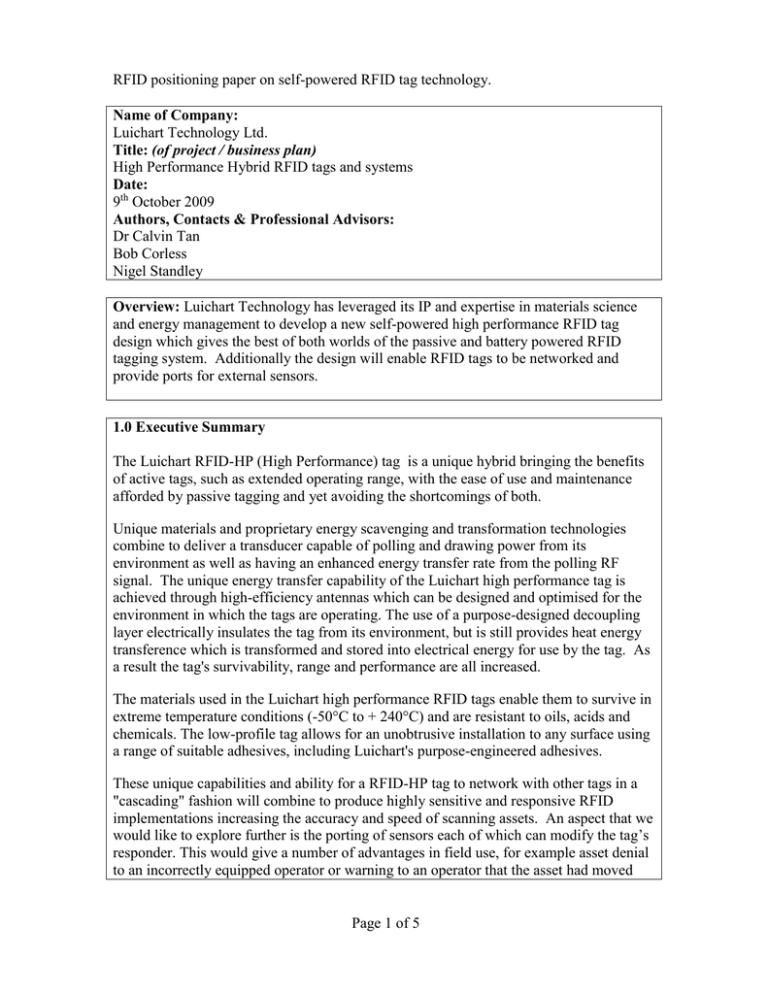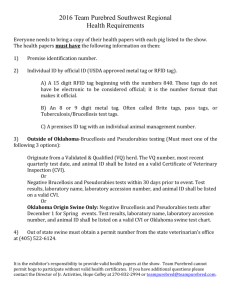RFID_Positioning_Paper
advertisement

RFID positioning paper on self-powered RFID tag technology. Name of Company: Luichart Technology Ltd. Title: (of project / business plan) High Performance Hybrid RFID tags and systems Date: 9th October 2009 Authors, Contacts & Professional Advisors: Dr Calvin Tan Bob Corless Nigel Standley Overview: Luichart Technology has leveraged its IP and expertise in materials science and energy management to develop a new self-powered high performance RFID tag design which gives the best of both worlds of the passive and battery powered RFID tagging system. Additionally the design will enable RFID tags to be networked and provide ports for external sensors. 1.0 Executive Summary The Luichart RFID-HP (High Performance) tag is a unique hybrid bringing the benefits of active tags, such as extended operating range, with the ease of use and maintenance afforded by passive tagging and yet avoiding the shortcomings of both. Unique materials and proprietary energy scavenging and transformation technologies combine to deliver a transducer capable of polling and drawing power from its environment as well as having an enhanced energy transfer rate from the polling RF signal. The unique energy transfer capability of the Luichart high performance tag is achieved through high-efficiency antennas which can be designed and optimised for the environment in which the tags are operating. The use of a purpose-designed decoupling layer electrically insulates the tag from its environment, but is still provides heat energy transference which is transformed and stored into electrical energy for use by the tag. As a result the tag's survivability, range and performance are all increased. The materials used in the Luichart high performance RFID tags enable them to survive in extreme temperature conditions (-50°C to + 240°C) and are resistant to oils, acids and chemicals. The low-profile tag allows for an unobtrusive installation to any surface using a range of suitable adhesives, including Luichart's purpose-engineered adhesives. These unique capabilities and ability for a RFID-HP tag to network with other tags in a "cascading" fashion will combine to produce highly sensitive and responsive RFID implementations increasing the accuracy and speed of scanning assets. An aspect that we would like to explore further is the porting of sensors each of which can modify the tag’s responder. This would give a number of advantages in field use, for example asset denial to an incorrectly equipped operator or warning to an operator that the asset had moved Page 1 of 5 outside of a safety envelope (too hot; too cold; impact damage; time expiry; immersion). 2.0 Market Analysis The implementation of RFID systems fall into two major categories: passive and active. Each has their own advantages and disadvantages. (See Table 1: Comparison of capabilities, page 4) Deployment of passive tags can be found in these typical industries:Drugs Other Healthcare Retail apparel Consumer goods Tires Postal Books Manufacturing parts, tools Archiving (documents/samples) Military Retail CPG Pallet/case Smart cards/payment key fobs Smart tickets Air baggage Conveyances/Roll-cages/Totes Animals Vehicles People (excluding other sectors) Passport page/secure documents Deployment of active or battery assisted tags::Pharma/Healthcare Cold retail supply chain Consumer goods Postal Manufacturing parts, tools Archiving (samples) Military Retail CPG Pallet/case Shelf Edge Labels Conveyances/Rollcages/ULD/Totes Vehicles People (excluding other sectors) Car security fobs It is expected a total of 2.35 billion tags will be sold in 2009, the majority of which will Page 2 of 5 be low-cost passive tags. In 2008 the following number of tags (millions) were sold into: Air baggage Animals Archiving (documents/samples) Apparel Books Car clickers Cold retail supply chain Consumer goods Conveyances/Roll-cages/Totes Drugs Manufacturing parts, tools Military Other Healthcare Passport page/secure documents People (excluding other sectors) Postal Retail apparel Retail CPG Pallet/case Shelf Edge Labels Smart cards/payment key fobs Smart tickets Vehicles Other Applications 60 90 9 130 85 48 0.01 8 28 10 70 55 15 65 1.3 2 130 200 0.2 559 325 7 130 Total market value in 2009 In 2009 IDTechEx find that the value of the entire RFID market will be $5.56 billion, up from $5.25 billion in 2008. This includes tags, readers and software/services for RFID cards, labels, fobs and all other form factors. The majority of this spend is on RFID cards and their associated services - totalling $2.99 billion. The market for RFID is growing and a large amount of this value is due to government-led RFID schemes, such as those for transportation, national ID (contactless cards and passports), military and animal tagging. Source: IDTechEx.com From 2007 to 2017, the Active RFID market is expected to double from its then 13% share, to 26% (or $7bn). The RFID market, and in particular the active RFID sector, appear to be following Moore’s law for semi-conductor design and cost; i.e. a doubling of capability each two years. The RFID technologies are quite mature, but with the onset of wireless technologies in general (Wi-Fi, Bluetooth, etc), RFID can become an intrinsic part of not Page 3 of 5 only asset tracking and management, but also as a part of a sensor network. Table 1: Comparison of capabilities Luichart Self-Powered Active (Battery) Passive Extended Operating Range > 50m Low Maintenance costs Low tag cost Highly survivable in hazardous conditions up to 240°C Ease of installation Adaptive wireless sensor network (porting of external sensors) Compatible with existing RFID systems Longevity of operation without intervention The Luichart tag will integrate with all existing systems and as a result there is a great opportunity to license the design to one of the major hardware suppliers like Motorola or Siemens. The Luichart tag would give them a huge competitive advantage over exisitng active-tag designs. It is unlikely that the current passive tag design will be usurped by the Luichart tag, however, there are business out there, like the brewing industry, where the passive tag does not give them operational excellence capabilities, and active tags are too expensive. The same can be said for suppliers who supply compressed gasses in bottles, including LPG. In the UK the brewing industry are considering the introduction of a deposit scheme to combat losses through theft. Because such a scheme would require tracking of everyone’s kegs and barrels, and provide transparency to all operators, the cost to introduce the scheme is a major barrier, but al acknowledge they’d like to do that. Discussions with Intellitap, a company dedicated to managing the assets of Scottish and Newcastle in the UK, have given a clear indication that if the self powered tag was available now and at the right price, they’d have no problem in deploying the tags as part of their offering to Scottish and Newcastle. The major attraction will be the ability to set up truck scanning portals where an entire load could be “read” on a drive through. 3.0 Technology Enablers Luichart’s IP in the area of polymer modifications for thermal and electrical properties, can be leveraged to allow existing RFID and energy scavenging technologies to be merged onto a single polymer substrate giving significant benefits for the end user. Each of the major components comprising the Luichart High Performance self-powered Page 4 of 5 tag have been developed and proven in isolation from one other. A technology demonstration program will provide an opportunity to engineer and fine the technologies into a workable and cost effective solution. Alongside the “hardware” technology is the “software” technology that will both control the tags operation and that with its peers or external sensors or networks. Wireless mesh networks are becoming more prevalent. The low cost, self powered design of the Luichart tag would further enhance the capabilities and payback of these networks through providing extended range of operation. 4.0 Costed Program 5.0 SWOT Analysis Strengths Unique technology enablers and IP to bring together proven technologies in an innovative way. Lower cost and superior capabilities to traditional active tag technologies. Weaknesses Integration issues not yet established, but it is not expected they will be “show stoppers”. Software requirements are unknown in order to enable wireless mesh network capabilities. Opportunities The RFID market is polarised between passive and active. The Luichart tag can bridge the cost gap and bring active performance to a wider audience. Current active-tag deployments would naturally look to a cheaper alternative on system upgrades Threats The active tag design is improving each year, reducing costs (initial and maintenance) and becoming a more attractive proposition. If the Luichart design is not developed now, then there is less opportunity in the future to keep or expand the price and operational capability “gap” with the active (battery assisted) tag. Page 5 of 5





